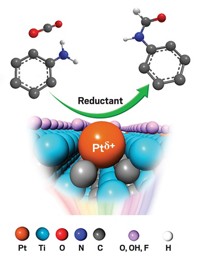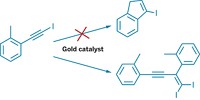Advertisement
Grab your lab coat. Let's get started
Welcome!
Welcome!
Create an account below to get 6 C&EN articles per month, receive newsletters and more - all free.
It seems this is your first time logging in online. Please enter the following information to continue.
As an ACS member you automatically get access to this site. All we need is few more details to create your reading experience.
Not you? Sign in with a different account.
Not you? Sign in with a different account.
ERROR 1
ERROR 1
ERROR 2
ERROR 2
ERROR 2
ERROR 2
ERROR 2
Password and Confirm password must match.
If you have an ACS member number, please enter it here so we can link this account to your membership. (optional)
ERROR 2
ACS values your privacy. By submitting your information, you are gaining access to C&EN and subscribing to our weekly newsletter. We use the information you provide to make your reading experience better, and we will never sell your data to third party members.
Synthesis
Nanoruthenium Readily Reduces Aromatics
Stabilizing Ru(0) nanoclusters within a zeolite framework permits solventless hydrogenations
by Bethany Halford
May 3, 2010
| A version of this story appeared in
Volume 88, Issue 18

By stabilizing ruthenium(0) nanoclusters within a nanozeolite framework, chemists at Middle East Technical University, in Ankara, Turkey, have made a heterogeneous catalyst that exhibits remarkable activity, selectivity, and lifetime in the hydrogenation of aromatics under mild conditions—25 °C and roughly 3 atm of H2 (J. Am. Chem. Soc., DOI: 10.1021/ja101602d). Because the catalyst works on neat aromatics, it offers a greener hydrogenation than catalysts that require solvents, say Mehmet Zahmakiran, Yalçin Tonbul, and Saim Özkar, who did the research. The team prepared the catalyst via borohydride reduction of a colloidal solution of nanozeolites that have undergone ion exchange with Ru(III). Upon investigating the catalyst’s properties, they discovered that during benzene hydrogenation to cyclohexane the catalyst will undergo 177,200 turnovers during the course of 105 hours before becoming deactivated. That’s the highest total turnover ever reported for this reaction and is 70 times greater than the previous record. In addition to benzene, the catalyst works well with substituted aromatics, such as toluene, o-xylene, and mesitylene. Furthermore, the catalysts are isolable, bottleable, and reusable, making them “superior” to many other hydrogenation catalysts, the researchers note.





Join the conversation
Contact the reporter
Submit a Letter to the Editor for publication
Engage with us on Twitter